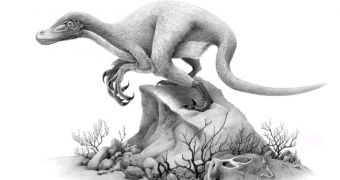In our minds, the word "dinosaur" is synonymous to huge.
But not all the dinosaurs were enormous beasts.
And perhaps the most interesting dinosaurs were found amongst the tiny ones.
Dromaeosaurs were mainly small, agile, gracile bipedal carnivorous dinosaurs that inhabited Asia and the Americas during the Cretaceous period (the last dinosaur era). They were highly evolved and closely related to birds, being covered by feathers and many of their fossils were found with the impression of their feathers.
Dromaeosaurs are dubbed "raptors," after Velociraptor, the most well known species - mainly because of the movie Jurassic Park - for its sickle claw and steely intelligence. Some species could fly, even using four wings!
Other had "hands"...
Recently, two new raptor species have been found in Mongolia, including one that could be the smallest non-avian dinosaur ever found.
One species, Tsaagan mangas, comes from the Ukhaa Tolgod region. Tsaagan was a little bit larger than a turkey and scientists could investigate one of the best-preserved Dromaeosaurid skulls ever discovered. "The skull of Tsaagan contains traits, such as expanded cheek bones and slight differences in the shape and positioning of skull cavities, that set it apart from all known dromaeosaurs," said Alan Turner, a paleontologist at the American Museum of Natural History (AMNH) in New York who participated on the investigation of the fossils.
"Tsaagan adds a really important data point when it comes to understanding variation within the skull and also basic skull morphology within dromaeosaurs," said Turner.
Tsaagan ("white monster" in Mongolian) lived about 80 million years ago, in the upper Cretaceous era. A skull, some neck bones and a shoulder bone were dug in 1993, but they were only recently described.
Jawbone fragments from the second raptor, Shanag ashile, came from the Oosh region. It lived roughly 20 million years earlier than Tsaagan and was much smaller, about the size of a crow. "Shanag" is a Mongolian dance and "ashile" is the rock formation were the fossil was discovered in. "Shanag likely resembled Microraptor, a feathered bird-like dinosaur discovered in China that scientists think coasted between trees on two sets of wings", said Turner.

 14 DAY TRIAL //
14 DAY TRIAL //